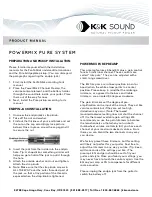
ATI
Q46H/63 Combined Chlorine System
Part 7 – Calibration
53
O&M Manual
Rev-K (11/18)
carefully inspect the sensor for a tear in the membrane. It will probably be necessary to
rebuild the sensor as described in section 5.4, Chlorine Sensor Assembly. Should the offset
value remain high and result in calibration failures, review the Service section of this manual,
and then contact the service dept. at ATI for further assistance.
The sensor zero offset value in nA from the last zero calibration is displayed on the lower line
of the Default Menus for information purposes.
7.12 Chlorine Span Cal
Span calibration of the system must be done against a laboratory measurement on the same
sample that the sensor is measuring. A sample should be collected from the inlet line feeding the
flow cell and quickly analyzed for chloramine. When calibrating, it is best to have a reasonably
high concentration of chloramine in the system. The higher the value, the smaller will be the
calibration errors caused by errors in the laboratory analytical procedure. It is generally
preferable to calibrate at values above 0.5 PPM to reduce calibration errors. The chlorine monitor
should be calibrated while operating on a chlorinated sample stream in the flow cell assembly.
Start flow cell and calibrate system as follows:
1. Place the sensor into the sensor chamber of the flow cell assembly. The sensor is inserted
into the side of the flow cell and is sealed in place with a double o-ring. The o-rings are
lubricated at the factory to allow the sensor to slide smoothly into place. If insertion becomes
difficult, use a small amount of silicon grease to lubricate the o-rings. If the low-volume flow
cell is used, screw the sensor into the flow cell until the membrane cap bottoms out on the
acrylic flow cell. Do not over-tighten
2. Turn on the inlet water flow to the flow cell and adjust the inlet flow rate so that water is
overflowing from the inlet chamber. The best performance will be obtained when some water
is always overflowing. This maintains constant flow and pressure on the sensor at all times.
3. Allow the system to operate undisturbed for 30-60 minutes. Assuming the water contains
chlorine, the display will be reading positive sensor current values. If the system is stable,
the value on the display will increase to some PPM value and remain at that level. At that
point, calibration can continue.
4. If the sensor is on-line, the user may want to set the output HOLD feature prior to calibration
to lock out any output fluctuations.
5. Scroll to the CAL menu section using the MENU key and press ENTER or the UP arrow key.
Cal Cl
2
will then be displayed.
6. Press the ENTER key. The screen will display a flashing
1-Ref
for span calibration or a
2-
Zer
for zero calibration. Using the UP arrow key, set for a
1-Ref
span calibration and press
ENTER.
7. The system now begins acquiring data for the calibration value. As data is gathered, the
units for ppm and temperature may flash. Flashing units indicate that this parameter is
unstable. The calibration data point acquisition will stop only when the data remains stable
for a pre-determined amount of time. This can be overridden by pressing ENTER. If the data
remains unstable for 10 minutes, the calibration will fail and the message
Cal
Unstable
will
be displayed.
















































